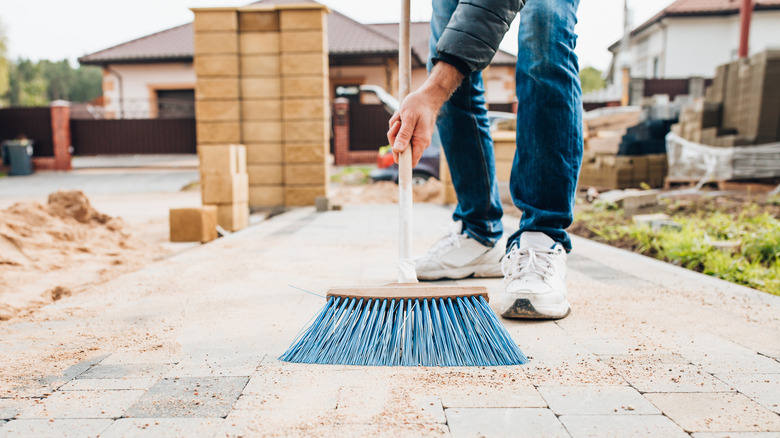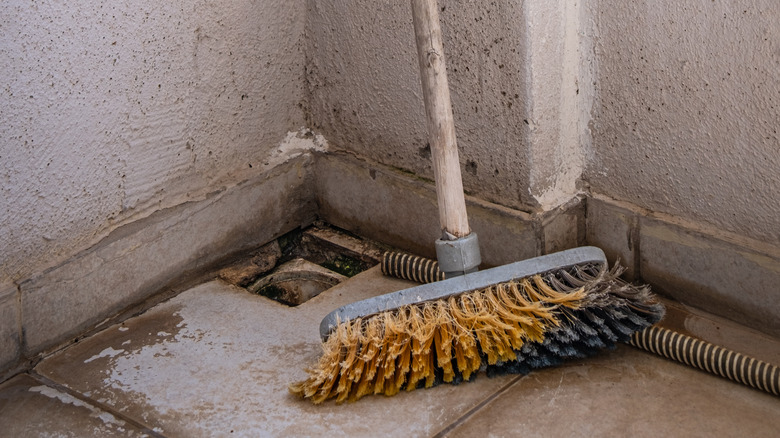The Common Mistake That's Easy To Make When Cleaning With A Broom
We may receive a commission on purchases made from links.
Come on, be honest: How long has that broom been hanging up in your mudroom? Are the bristles on the broom you sweep the kitchen with sticking out every which way? Viral sweeping hacks claiming to make the chore more efficient only go so far if your broom is old and dirty. Each swish of the broom head deposits debris onto your floor instead of rounding it up to collect in a dustpan. That's right; forgetting to switch out an ancient brush is a surprisingly common housekeeping error — and one that's costing you time and making what should be one of the most simple cleaning chores a, well, chore.
Pushing your broom across a surface puts pressure on the bristles; without care, they'll bend, break, and fall out. A sweeper with mangled or sparse bristles isn't going to pick up much. If the comb is made of porous natural materials like animal hair, palmyra, Tampico, or corn fiber, it will soak up and retain dirty water, oils, and anything else liquid you sweep up, depositing it back onto the floor the next time you clean. Improperly stored natural fiber brooms may attract mold and mildew, which you subsequently spread all over your home. Plastic-bristled brooms, with combs made of nylon or polypropylene, are more durable than their natural counterparts, but they're not impervious to ruin. For example, store them leaning against a wall, broomhead on the floor rather than hanging, and the bristles will bend. You can't beat gravity.
A clean sweep
According to a 2022 Statista poll, about half of the Americans surveyed (50.1%, to be exact) admitted to replacing their brooms once every two years. While some cleaning experts say this is often enough, most hesitate to put a timeframe on broom replacement. Instead, observing your sweeping implement's performance will tell you when it's time.
If the broomhead is leaving a trail of dust and debris in its wake, it's time to go shopping. Another way to tell if your broom needs replacing is when "a broom reaches half its filament length," says Perry Stenzel, a salesman at United Rotary Brush Corp, via FORConstructionPROS.com. Though he's talking about brooms used on building sites, the bristles of which see far more wear than a household sweeper, even one used outdoors, it's still a good rule of thumb. Bent or thinning bristles are another sign replacement is in order. And, obviously, if the broom head is wobbly or falling off the handle, it's time to replace the head, the handle, and/or the entire broom.
If the handle is still in good shape, replacing the broom head is often cheaper and more eco-friendly. Less waste is always a good thing! Some broom manufacturers lock consumers into a system — you have to buy their handles, broom heads, and other accessories. If you want to avoid that, look for broom heads designed to fit any standard handle width, like the indoor-outdoor option from Fuller going for $54.99 on Amazon.
Extend its life
You can also try to extend the life of any broom as much as possible to limit how much you fork out on replacements. Chop the ends off bent or fraying bristles using sharp scissors, just as you would your bangs. Aim to remove around an inch or so each time you do it. Cleaning your broom is essential to encourage longevity, but how often is up for debate. Recommendations oscillate between cleaning it every time you use it to once every three months. Experiment to see what works best for your particular brand and type of broom. Vacuum out embedded debris, then hang your broom in a clean, dry place — the broom head facing up — rather than leaning it against the wall with the broom head touching the floor. This ensures proper airflow, banishing bad smells.
No matter how well you care for your existing broom, you'll eventually need to replace it. When this time arrives, consider where and how you'll use your new implement before swiping that card. Outdoor brooms need tough bristles for rough surfaces — Walmart sells a Libman 24-inch multi-surface push broom for $19.97. Indoor brooms, on the other hand, should be lightweight with soft bristles. This easy-to-clean, pet-hair-collecting silicone brush and dustpan set from Dotti for $85 fits the bill. When your new sweeper arrives, repurpose that old broom around the house by turning it into a boot scrubber, duster, lawn decor, or any number of other creative reuses.


